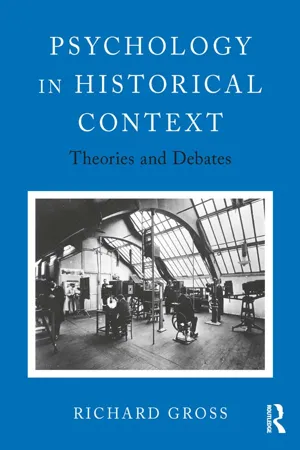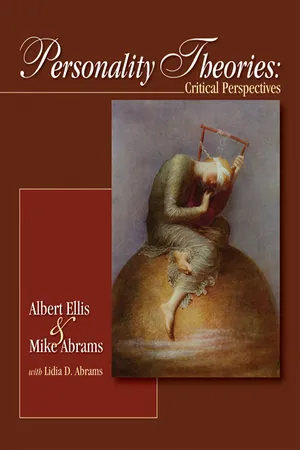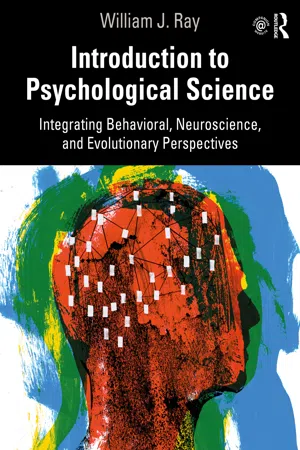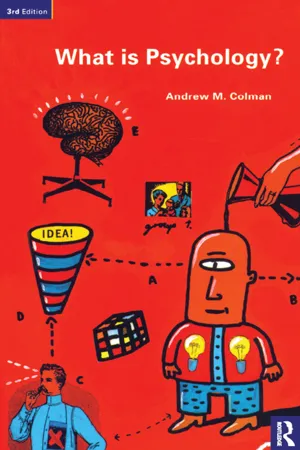Psychology
Schools of Thought
Schools of thought in psychology refer to the various theoretical perspectives and approaches used to understand and explain human behavior and mental processes. These schools of thought include behaviorism, psychoanalysis, humanism, cognitive psychology, and others, each with its own unique principles and methods for studying the mind and behavior.
Written by Perlego with AI-assistance
Related key terms
Related key terms
1 of 4
Related key terms
1 of 3
7 Key excerpts on "Schools of Thought"
- eBook - ePub
Early Childhood Studies
A Social Science Perspective
- Ewan Ingleby(Author)
- 2012(Publication Date)
- Bloomsbury Academic(Publisher)
The schools of psychologyOne answer to this question is that there is no definite answer. Philosophers have speculated for hundreds, perhaps thousands, of years about what has come to be known as ‘the mind-brain problem’. Whether you focus upon the mind or the brain depends upon your fundamental understanding of how psychology should be studied. Many psychological perspectives such as behaviourism, humanism, psychodynamic and cognitive theories emphasize the importance of the mind. This is because each of these perspectives has a clear understanding or model of the mind. In contrast biological perspectives are more likely to place an emphasis upon the genes and hormones influencing the brain.We can now look at exploring some of the psychological perspectives. This is a way of adding detail to our introductory explanations of what the subject area of psychology is. It is also a means of setting the scene before we look at how psychology can be applied to early years practice and Early Childhood Studies in particular.Table 1.1 gives a summary of five major schools of psychology together with a brief description of their key features.These Schools of Thought are especially useful to practitioners working with children and families because of the influence they have had in shaping the academic concerns of psychology. The practical application of this academic discipline appears to relate to much of the work that is undertaken with children and families. If you are working with children and families you will need to apply psychology through ‘modelling’ best practice and meeting the needs of children and families in an assertive manner. Knowledge and understanding of the competing perspectives in psychology can help you to achieve this ‘best practice’. The origins of the Schools of Thought go back to some of the earliest philosophical ideas to have influenced Western thought. The proposition that there are forces beyond the individual that shape social reality goes back to the ideas of the Greek philosopher Plato. This idea is central to behaviourism so the perspective has its intellectual origins in this classical thought. The notion that individuals interpret their social world as opposed to being ultimately shaped by this world goes back to the ideas of Aristotle (Audi, 1995). This philosophy is of central importance to humanism. In other words the genesis of the perspective’s dominant idea can be traced back to these early times. A summary of each of the key perspectives developing the definitions given in Table 1.1 - eBook - ePub
Psychology in Historical Context
Theories and Debates
- Richard Gross(Author)
- 2017(Publication Date)
- Routledge(Publisher)
Chapter 1 Historical perspectives Psychology as the study of … what?If there’s a logical place to start one’s study of Psychology, it’s by looking at how it came to be where it is now; in other words, its history. But as we shall see below, this isn’t as straightforward as it may sound: there are different ways of ‘doing history’ and different resultant histories. Put another way, there’s more than one history of Psychology.Some may disagree with the premise that we should start with Psychology’s past, claiming instead that the logical starting point is to decide what Psychology is about, its subject-matter. But again, this too is a matter of debate and disagreement. In terms of one of its histories, Psychology’s subject matter (its ontology) is defined differently by different Schools of Thought or theoretical approaches, which have developed over time (roughly, the past 140 years, albeit with considerable overlap between them). Part of this debate relates to similarities and differences between human beings and non-human animals; sometimes this is addressed directly, sometimes it’s ignored altogether.These approaches (such as Structuralism, Behaviourism, and Cognitive Psychology) differ not only in terms of what they consider the appropriate subject-matter to be, but also in terms of the methods used (or advocated) for studying this subject-matter. This relates to the debate regarding the nature of science (in general) and the validity and appropriateness of using certain methods to investigate human beings/people (in particular).The implication of the preceding paragraphs is that, regardless of how we view Psychology’s history, and regardless of how its subject-matter is defined, Psychology adopts a scientific approach. This, in turn, begs two major questions: (1) What do we mean by science? And (2) what kind of science is/should Psychology be? These questions relate to epistemology and methodology - eBook - ePub
Child and Adolescent Psychology
Typical and Atypical Development
- Stephen von Tetzchner(Author)
- 2018(Publication Date)
- Routledge(Publisher)
2 THEORETICAL PERSPECTIVESThis chapter provides a brief introduction to the foundations of theory formation and the most important theoretical perspectives in developmental psychology: psychodynamic psychology, behaviorism, logical constructivism, social constructivism, evolutionary psychology, ethological psychology, ecological psychology, information processing and critical psychology. They differ in their emphasis and explanations of developmental phenomena and together they illustrate the breadth of developmental thinking in the twenty-first century. Each of them comprises many assumptions and hypotheses, and constitutes a basis for many smaller theories.The theories are presented in more detail in parts of the book where they are relevant, including critical comments. Chapter 10 , for example, discusses the cognitive aspects of the theories, while Chapter 18 discusses the development of personality.THE FUNCTION OF DEVELOPMENTAL THEORIES
Developmental theories are intellectual tools for categorizing and making sense of observations of children’s actions and reactions and their environment, and explaining typical and atypical developmental trajectories. As all tools, they must be functional and solid. A good theory requires a coherent set of interconnected concepts and a terminology that can be used to describe the development of the psychological phenomena and explain the relevant processes, for example concepts that can characterize children’s changing thinking or emotion understanding, and the processes that underlie these developmental changes (see Chapters 10 and 17 ). “The usefulness of theories may be evaluated in regard to its attributes of precision, scope and deployability” (Lerner, 2002, p. 11).According to Popper (1959), a theory has to be testable in order to be scientific. The first test of whether a theory is sound and tenable is to establish if it can account for and integrate existing research findings (Lerner, 2002). Popper also points out that theories cannot be proven - eBook - ePub
Psychology's Territories
Historical and Contemporary Perspectives From Different Disciplines
- Mitchell Ash, Thomas Sturm(Authors)
- 2007(Publication Date)
- Psychology Press(Publisher)
Psychological thinking in the broadest sense—including conceptions of human nature and subjectivity—has played a fundamental role in the formation and history of every discipline that deals with human affairs. Because many of these disciplines emerged before psychology did and have often developed quite independently of psychology, limiting our perspective to the internal history of academic psychology is insufficient to the task at hand. All forms of psychological thinking, wherever they may be located institutionally, could and should be included in principle within the purview of the analysis proposed here, although of course a comprehensive survey is not possible. Similar considerations also apply to the multiple interrelationships between the psychological disciplines and the use of psychological vocabularies by non-academics, which have their own history. 2. The common assumption that methodologically controlled use of research tools effectively insulates psychology both from other disciplines and from lay practices can and should be questioned, for two reasons. First, as recent historical research has shown, the same tools have been made to work in varied disciplines over time, whereas the uses and meanings of such tools change in various ways while they ‘travel’ from one context of use to another (see, e.g., Benschop & Draaisma, 2000; Schmidgen, 2005). Their belonging-ness to a particular discipline is thus determined not only by specificities of machine design, but also by contexts of use (Gundlach, chap. 9, this volume; see the following section). Second, the history of re search practices in any science is as important as the history of concepts and theories, because the two can be quite independent of one another - eBook - ePub
Personality Theories
Critical Perspectives
- Albert Ellis, Mike Abrams, Lidia Dengelegi Abrams(Authors)
- 2008(Publication Date)
- SAGE Publications, Inc(Publisher)
In 1920, Watson conducted an experiment at Johns Hopkins that would not be permitted by any medical ethics committee in the early 2000s. He deliberately conditioned an 11-month-old child known as Little Albert to experience fear in the presence of such originally neutral stimuli as tame white laboratory mice and rabbits by making a loud noise while the child was enjoying quiet play with the animals. Moreover, Watson never deconditioned Little Albert to remove the fears he had induced in the little boy. For nearly half a century, behaviorism was the overwhelmingly dominant school in psychology.Under the influence of B. F. Skinner, one of the few psychologists to have published a novel (Walden Two) as well as scientific articles, behaviorism attempted to explain every facet of human behavior and development. Love, war, mating, language, and the development of societies were all explained in terms of contingencies of reinforcement. Language was a collection of those sounds that were reinforced after being distilled from the noises that the child randomly expressed during development. Affection, too, was a collection of behaviors reinforced by members of the opposite sex. At its high point, behaviorism was able to account for all actions of humans and the higher animals through the pattern of stimulus and response. But like Ptolemy’s model of the celestial movements, behaviorism was based on some fundamental misconceptions. Its explanatory power then began to show severe weaknesses.Photo 2.2 Wolfgang Köhler (1887–1967)Gestalt Psychology
You have probably heard a variation of the maxim that “we are greater than the sum of our parts.” This is a variant of the defining principle of the Gestalt school of psychology, which had its origins in Germany around 1912. Gestalt - eBook - ePub
Introduction to Psychological Science
Integrating Behavioral, Neuroscience and Evolutionary Perspectives
- William J. Ray(Author)
- 2021(Publication Date)
- Routledge(Publisher)
Brown v Board of Education, to show that segregated schools were problematic and did not benefit the students involved. This was an important use of psychological research to help inform decisions in terms of social policy.CONCEPT CHECK- What is the focus of Gestalt psychology? What is its specific contribution to research in perception?
- For the behaviorists, what were the critical areas of focus in psychology? On the other hand, what areas were considered out of bounds?
- What are the primary areas of interest in cognitive psychology? What contributions did this approach make to research in psychology in terms of the scope of inquiry, experimental design, and technological innovation?
- Sigmund Freud was instrumental in the beginning of clinical psychology. What are the primary ideas and techniques of his psychodynamic perspective?
- What are the three key characteristics of Carl Rogers’s client-centered therapy?
- In what ways does the cognitive behavioral perspective combine the traditions of the separate behavioral and cognitive approaches?
- What are “empirically supported therapies,” and what is their contribution to the field of psychology?
- What is the biopsychosocial perspective, and what is its contribution to the field of psychology?
- What were some early contributions by women in psychology? How does the changing role of women in psychology reflect broader changes in US society?
- Who were some early African American psychologists who shaped our perspectives?
The Three Major Themes of This BookPsychology’s maturing as a discipline over the past 130 years has led to many useful ways to understand and study how we humans think, act, and engage with others. These different approaches will be described, and emphasis will be placed on three major themes in this text: (1) behavior and experience, (2) neuroscience, and (3) human origins and a historical cultural perspective. Let us now look at these three themes. - eBook - ePub
- Andrew Colman(Author)
- 2016(Publication Date)
- Routledge(Publisher)
The Lancet, and the University Council passed a resolution forbidding “the practice of mesmerism or animal magnetism within the Hospital”. In 1842 a surgeon performed a leg amputation on a hypnotized patient who apparently felt no pain during the operation, but when he reported the case to the Royal Medical and Chirugical Society, the record of his paper was struck from the minutes on the grounds that surgery without pain is immoral and that “patients ought to suffer pain while their surgeons are operating”. It is hardly surprising that psychology was slow to penetrate the conservative academic and scientific establishment in Britain.The era of schoolsFrom the end of the nineteenth century until the 1930s, psychology was fragmented into several more or less independent schools that were at loggerheads with one another on theoretical issues, research methods, and the kinds of psychological processes that they considered worthy of study. Structuralism and functionalism sprang out of the philosophical and biological antecedents of psychology – associationist philosophy and evolutionary theory respectively. Behaviourism and Gestalt psychology arose initially as revolts against the other schools. Psychoanalysis developed independently outside the academic establishment. By the end of the Second World War the schools had declined, although psychoanalysis continued to thrive as an organized profession outside the mainstream of academic psychology, and a modified form of neo-behaviourism remained influential. But long after the decline of the schools, current areas of psychological research retain unmistakable traces of their historical origins.StructuralismThe structuralist school of psychology was based chiefly on Wundt’s Outlines of Psychology, published in Germany in 1897, and Edward Bradford Titchener’s An Outline of Psychology
Index pages curate the most relevant extracts from our library of academic textbooks. They’ve been created using an in-house natural language model (NLM), each adding context and meaning to key research topics.
Explore more topic indexes
Explore more topic indexes
1 of 6
Explore more topic indexes
1 of 4






